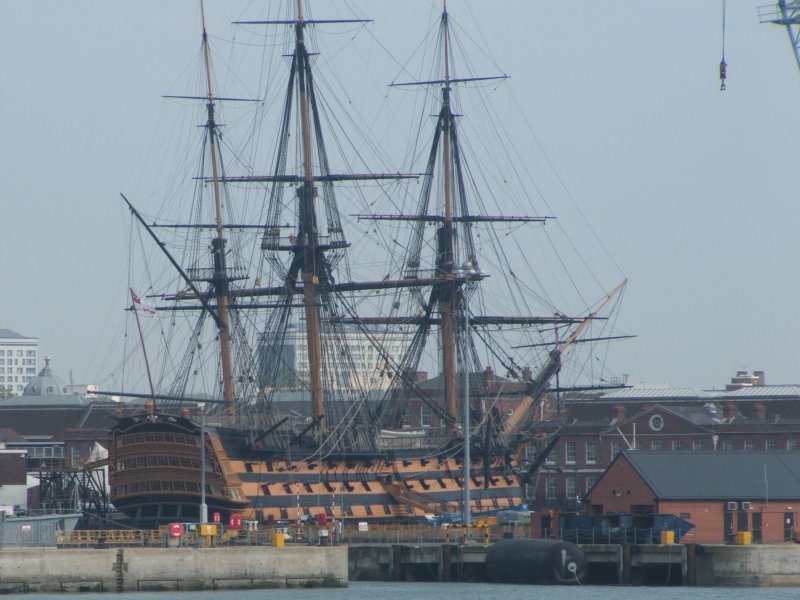« Terror and bullying | Main | Efficiency. »
May 11, 2006
The World's Oldest Commissioned Warship
One of the highlights during my recent visit to England and Scotland undoubtedly was a day at the Historic Dockyard in Portsmouth. Much to the Monk's astonishment Portsmouth greeted us with bright sunshine. Apparently it usually tries its best to live up to the old myth that it is forever raining in England.
One cannot, of course, stroll through the dockyard without having a closer look at the HMS Victory, Admiral Nelson's famous flagship in the Battle of Trafalgar in 1805. She is a beautiful ship although she was built for one purpose only: destruction.

The HMS Victory in dry dock in Portsmouth
The HMS Victory was designed as a fighting machine. Three decks carried three different sizes of guns: 30 x 32 pounders on the lower deck, 28 x 24 pounders and 30 x long 12 pounders on the upper deck. There were additional smaller guns on the quarter deck and fo'c'sle. Each pair of 32 pounders was operated by a crew of fifteen. Reloading and firing a gun is quite a complicated business, especially if you have to do it on a dark, smoke-filled gun deck. Nelson's seamen were so very well trained that they could reload and fire these heavy guns within 90 s, which gave them a clear advantage over their enemies. Moreover the Victory is said to have been an excellent sailing ship making 8 knots at top speed.
On entering the ship one is astonished how low the ceilings are and instantly starts to wonder what life must have been like on a ship like that. The crew at Trafalgar comprised 821 men. About 500 of them lived on the lower gun deck. As the gun ports were usually kept closed it must have been dark, damp and extremely smelly down there. The men slept in hammocks of 400 mm width. That is so narrow actually that they had to sleep with their heads next to the feet of their neighbours! The stench of unwashed bodies must have been overpowering but probably the human nose just shuts down in situations like this.
Food and drink supplies on the other hand were generous, amounting to something like 5000 calories per day: cold oatmeal porridge for breakfast, salted meat stew cookes in the galley for dinner and biscuits and cheese for dinner. It was a pity that the ship's biscuits were soon invaded by weevils who had to be shaken out by gently tapping the biscuit on the table before eating it. Small wonder most seamen apparently preferred to enjoy their biscuits in darkness ... Drink consisted of half a pint of rum a day mixed with (often salty) water. But getting drunk was a major offence and would be punished. Discipline was very strict on board. I suppose it had to be considering the living conditions on a ship like that.
Still - considering the general living conditions of poorer people in the 18th/19th century the seamen were probably not that badly off. They had a sheltered place to stay, they had work and income, and they had sufficient food each day. That is probably a lot more than a worker in a coal mine had at that time. And they would often sail for years before they had to go into battle. Out of the 821 that went to Trafalgar surprisingly few were actually killed and wounded.
On the other hand I would very easily forego the experience of being a 'powder monkey', boys aged between 8 and 14 years, during battle on board the Victory. You had to feel your way down to the lowest deck where the sacks of powder for the guns were filled. For the three different types of cannons, three differently sized powder bags were stored in three different places so that the risk of mix ups was kept to a minimum. You had to take the powder bags and hurry back to your place through darkness and most probably silence as most of the seamen on the gun decks went deaf after the first salvo was fired. And those on the lower decks weren't even able to see what was coming their way. I know, I'd suffer badly from claustrophobia.
Mind you, on deck things can't have looked much brighter in a battle. Broadsides were usually fired at each other at close quarters, different types of cannon balls were designed to do maximum damage and snipers were aiming at you from the opposing ship. One of those mortally wounded Lord Nelson on October 21, 1805, who died a few hours later.

You certainly wouldn't want to see her coming at you like this ...
After a day around the docks you wonder why so much effort, thought and creativity always seems to go into the building of weapons and war machinery.
Posted by Mausi at May 11, 2006 06:00 AM
Trackback Pings
TrackBack URL for this entry:
http://mt3.mu.nu/mt/mt-tb.cgi/4258
Comments
The Dutch 7 Provincien was a much stronger warship!
Posted by: J G at May 7, 2007 12:12 PM
Quite possibly - but she wasn't preserved and never faced the Victory.
Posted by: The Gray Monk at May 7, 2007 10:37 PM